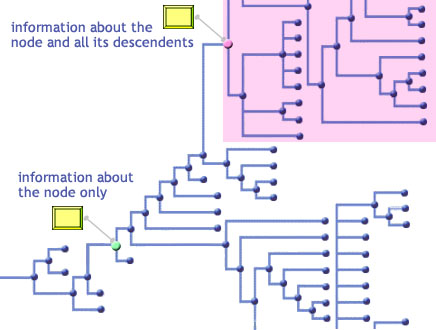Technical Development: Information Architecture
Objects Attached to Nodes
 All of the information used in the Tree of Life Web Project (other than
the tree structure itself) is represented by objects that are attached
to nodes in the tree. An object might be an image or a text section,
for example (see Classes of Objects below).
All of the information used in the Tree of Life Web Project (other than
the tree structure itself) is represented by objects that are attached
to nodes in the tree. An object might be an image or a text section,
for example (see Classes of Objects below).
An object is attached to a particular node in the tree. It may be attached to more than one node; e. g., a picture of a black stork eating a marsh frog would be attached both to the stork node and to the frog node. Also, there would be many different images of marsh frogs attached to that node along with objects of other classes such as movies, sounds, text contributions, information about people who work on marsh frogs, etc.
An object may be attached to a node because it contains information relevant to that particular branching point in the tree (e.g., a reconstruction of the common ancestor of all amniotes), or it may contain information relevant to this node and all of its descendents (e.g., a description of the basic features of the cephalopod eye).

In the latter case, objects attached to nodes deep in the Tree of Life would apply to large, more inclusive groups, e.g., all plants, all fungi, all hexapods, etc. and objects attached to nodes higher up in the tree would apply to less inclusive groups, up to the level of individual species and subspecies.
When we attach objects to relevant nodes in the tree, these objects will automatically become organized hierarchically, according to phylogenetic hypotheses.
Classes of Objects
There are many different kinds or classes of objects that can be attached
to nodes in the Tree of Life Project. Some of these classes are "officially"
supported by the Tree of Life Project, and they are stored in the project's
internal databases. These native ToL objects include:
- names: scientific names, valid names as well as synonyms, common names
- media: images, sounds, movies, interactive media
- text: descriptions, discussions, essays, lists, glossary definitions
- taxon properties: incertae sedis status, phylesis (monophyletic or paraphyletic), and extinct or not.
- page objects: see Presenting Information on ToL Pages
- people: authors, experts, enthusiasts, copyright owners, institutions
Generally, ToL objects have a title, a creator, copyright owner and copyright dates. Information about creators and copyright owners is stored in a People Database containing contact information, etc. Image and other objects are stored in a Media Database, along with information about the media file: its size, subject matter (whole organisms, habitat, etc.), format, how the copyright owner wants the material to be used, etc.
In the future, there will also be a mechanism for registering other classes of objects to be attached to nodes in the tree. These objects will usually be stored in other databases which then link to the ToL database and vice versa. Some examples of such custom objects may be:
- molecular sequence data
- presence or absence of a characteristic, like a particular biochemical pathway, a morphological, or life history trait
- conservation status of a group of organisms
- estimated age of branching points in the tree
- numerical data, like chromosome numbers, number of limbs or digits, number of instars, etc.
- cultural references, like poems, songs, or other works of art
Information Architecture of the Tree of Life Project:
- Nodes and the Shape of the Tree
- Objects Attached to Nodes
- Harvesting ToL Data
- Presenting Information on ToL Pages
 Go to quick links
Go to quick search
Go to navigation for this section of the ToL site
Go to detailed links for the ToL site
Go to quick links
Go to quick search
Go to navigation for this section of the ToL site
Go to detailed links for the ToL site